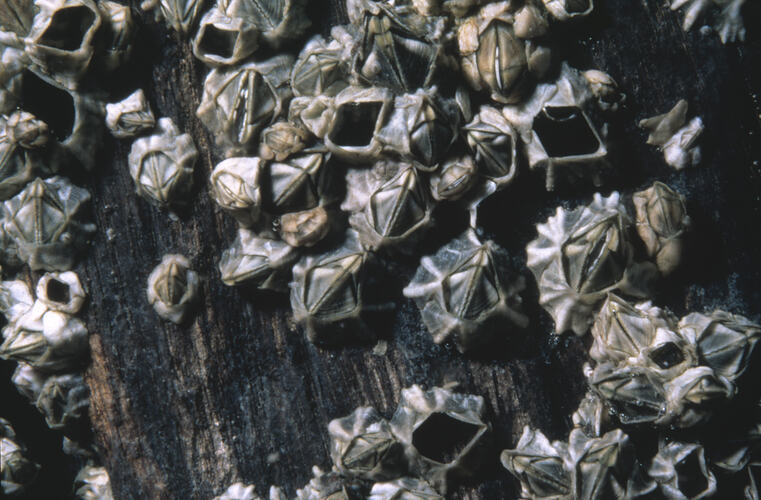General Description
Four brown side plates (red-brown in young animals), with white ridges that radiate from the opening to the edge. Six pairs of black spots on the white mantle (seen in the opening when the animal emerges). Opening pentagonal shape. Up to 5 mm high, 2 cm wide.
Biology
To the uninitiated, barnacles might seem to be molluscs, like limpets, which they superficially resemble and with whom some share space. This is because the chalky plates that enclose the crustacean body are vaguely limpet-shaped. Inside the "shell" however is a segmented body with six pairs of segmented legs used for filter-feeding from the water. Surprisingly, the sexes of barnacles are separate. The males have, proportionately, probably the largest penis in the animal kingdom. It reaches out of the shell and transfers its sperm to a female neighbour. After fertilisation, the female barnacle broods its eggs until they hatch as minute larvae called nauplii, which swim until they transform to another larval stage called a cypris that then settles head-down on a suitable surface. The Secret Four-plated Barnacles live in similar habitats to the related Modest Four-plated Barnacle, but usually attach to rocks higher on the shore.
Distribution
Southern Australia.
Habitat
Estuaries and sheltered bays, at mid to high tide levels.
More Information
-
Animal Type
-
Animal SubType
-
Brief Id
White ridges, four brown side plates, six black spots on mantle.
-
Colours
Brown, White
-
Habitats
-
Diet
Plankton or Particles
-
Endemicity
-
Commercial
No
-
Conservation Statuses
CITES: Not listed, FFG Threatened List: Not listed, EPBC Act 1999: Not listed, IUCN Red List: Not listed
-
Depths
Shore (0-1 m)
-
Water Column Locations
On or near seafloor
-
Taxon Name
-
Scientific Author
(Foster, 1982)
-
Common Name
Secret Four-plated Barnacle
-
Phylum
-
Subphylum
-
Class
-
Subclass
-
Superorder
-
Order
-
Suborder
-
Family
-
Genus
-
Species Name
covertus

